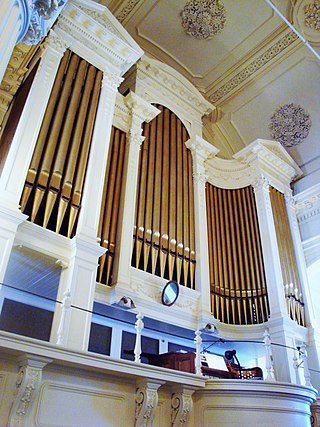
Aeolian-Skinner Organ Company, Inc. of Boston, Massachusetts was an American builder of a large number of pipe organs from its inception as the Skinner Organ Company in 1901 until its closure in 1972. Key figures were Ernest M. Skinner (1866–1960), Arthur Hudson Marks (1875–1939), Joseph Silver Whiteford (1921-1978), and G. Donald Harrison (1889–1956). The company was formed from the merger of the Skinner Organ Company and the pipe organ division of the Aeolian Company in 1932.

Bernard Ralph Maybeck was an American architect. He worked primarily in the San Francisco Bay Area, designing public buildings, including the Palace of Fine Arts in San Francisco, and also private houses, especially in Berkeley, where he lived and taught at the University of California. A number of his works are listed on the National Register of Historic Places.

Casavant Frères is a Canadian organ building company in Saint-Hyacinthe, Quebec, which has been building pipe organs since 1879. As of 2014, the company has produced more than 3,900 organs.
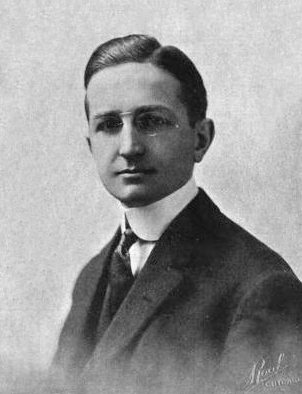
Ernest Martin Skinner was an American pipe organ builder. His electro-pneumatic switching systems advanced organ-building technology in the first part of the 20th century.
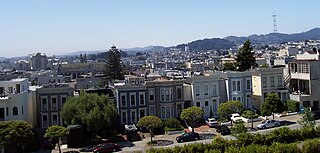
The Western Addition is a district in San Francisco, California, United States.
The Holtkamp Organ Company of Cleveland, Ohio is America's oldest continuously operating pipe organ workshop. The company was founded in 1855 by Gottlieb Votteler. The work produced by the shop has evolved over the years in terms of architectural style, sound, and mechanism. During this time, the company has had a number of names, including: The Votteler Organ Company, The Votteler-Hettche Organ Company, The Votteler-Holtkamp-Sparling Organ Company, and finally in 1951, The Holtkamp Organ Company.
George Donald Harrison was responsible for the design of some of the finest and largest pipe organs in the United States. Born in Huddersfield, England, he first worked as a patent attorney in 1914 but after military service he began to pursue an interest in pipe organ building, working with Henry Willis & Sons of London.

Austin Organs, Inc., is a manufacturer of pipe organs based in Hartford, Connecticut. The company is one of the oldest continuously-operating organ manufacturers in the United States. The first instruments were built in 1893 with the Austin Patent Airchest, and many remain in fine playing condition to this day.
The Wangerin Organ Company (1912-1942) was a manufacturer of pipe organs based in Milwaukee, Wisconsin. It was a continuation of the company after the partnership of Adolph Wangerin and George J. Weickhardt, Wangerin-Weickhardt, ended with the death of Weickhardt in 1919. It had previously also been known as the Hann-Wangerin-Weickhardt company. Many of its organs are still played in churches today.
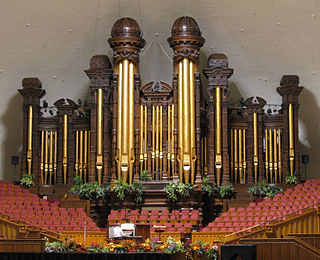
The Salt Lake Tabernacle organ is a pipe organ located in the Salt Lake Tabernacle in Salt Lake City, Utah. Along with the nearby Conference Center organ, it is typically used to accompany the Tabernacle Choir at Temple Square and is also featured in daily noon recitals. It is one of the largest organs in the world. Jack Bethards, president and tonal director of Schoenstein & Co., describes it as an "American classic organ" and "probably one of the most perfect organs ever built."
Pipe organs that are tuned in meantone temperament are very rare in North America. They are listed here, by type of temperament and sorted by date of construction. North America is defined here as Canada, the United States of America and Mexico. All instruments listed are playable but unplayable instruments may be added with a note.

McAllister Tower Apartments, also known as the William Taylor Hotel, is a 28-story, 94 m (308 ft) residential apartment skyscraper at 100 McAllister Street in San Francisco, California. The property is owned and operated by the University of California, Hastings College of the Law. The tower includes mixed-use offices on various floors, and the Art Deco-styled "Sky Room" with a panoramic view on the 24th floor.

The Schoenstein Organ at the Conference Center is a pipe organ built by Schoenstein & Co., San Francisco, California located in the Conference Center of the Church of Jesus Christ of Latter-day Saints in Salt Lake City, Utah. The organ was completed in 2003. It is composed of 160 speaking stops spread over five manuals and pedals. Along with the nearby Salt Lake Tabernacle organ, it is typically used to accompany the Tabernacle Choir at Temple Square. Schoenstein & Co.'s president and tonal director, Jack Bethards, describes it as "an American Romantic organ" that is "probably more English than anything else."
Kilgen was a prominent American builder of organs which was in business from the mid-19th to the mid-20th century.
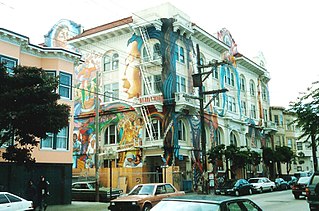
The Women's Building is a women-led non-profit arts and education community center located in San Francisco, California. The center advocates self-determination, gender equality and social justice. The four-story building rents to multiple tenants and serves more than 20,000 women a year. The building has served as an event and meeting space since 1979, when it was purchased by the San Francisco Women's Center. The Center is shielded from rising real estate costs in the Mission District because it owns the building free and clear, having paid off the mortgage in 1995.
Clinton Day was an American architect, active on the West Coast of the United States.

Hinners Organ Company was an American manufacturer of reed and pipe organs located in Pekin, Illinois. Established in 1879 by German-American John Hinners, the firm grew through several partners, becoming Hinners & Fink in 1881, Hinners & Albertsen in 1886, and Hinners Organ Company in 1902. In the 1920s Hinners established a subsidiary, the Illinois Organ Supply Company, which mass-produced parts for Hinners and other firms. Business declined in the 1930s due to the Great Depression, changing technology, and increasing competition. Hinners became a service company in 1936 and closed in 1942.
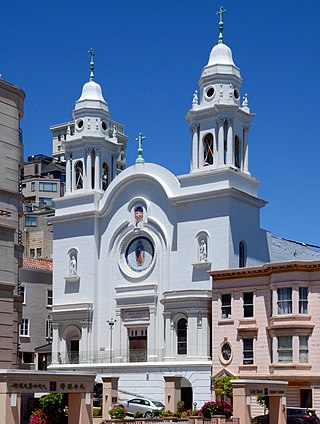
The Church of Our Lady of Guadalupe, is a former Catholic church located at 906 Broadway above the Broadway Tunnel in the Russian Hill neighborhood of San Francisco, California, United States. Built in 1912 as a replacement for an 1880 church that was destroyed by the 1906 San Francisco earthquake and ensuing fire, it closed in 1992 and has most recently been redeveloped as a tech business incubator and event space with the adjacent rectory converted to co-living spaces. It is a designated city landmark.

Saint Francis of Assisi Church is a historic Norman Gothic Catholic church building in the North Beach neighborhood of San Francisco, California, United States. Its an early church in California, outside of the Spanish missions. It is also known as the St. Francis Parish, and the National Shrine of St. Francis of Assisi.



















